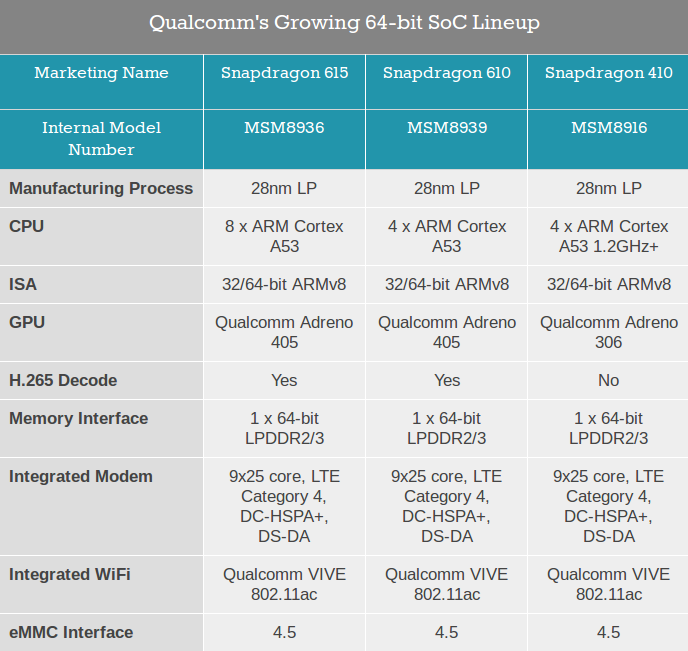MWC 2014 will apparently be the event where 64-bit ARM mobile SoCs are to be announced. After the official launch of Mediatek MT6732, and the soon-to-be-announced Samsung GH7, Qualcomm has unveiled two new ARMv8 processors, namely Snapdragon 610 (MSM8939) and Snapdragon 615 (MSM8936), respectively featuring 4 and 8 ARM Cortex A53 cores and targeting the mid-range of the market.

Both processors will be manufactured using 28nm LP process technology, and features the new Adreno 405 GPU with support for OpenGL ES3.0, OpenCL, and DirectX 11.2 support, and up to 2560 x 1600 resolution, support H.265 video decoding, and integrates an LTE category 4 modem, as well as 802.11ac Wi-Fi via Qualcomm VIVE.
Anandtech explains that “Snapdragon 615 is made up of two quad-core clusters, each optimized for a different operating point. One cluster is optimized for low power operation while the other cluster is optimized for high performance. This will likely manifest in four cores being able to run at a higher frequency than the other four, although Qualcomm tells me that all eight cores can be operational at the same time should a workload demand it.” So it looks like some sort of big.LITTLE configuration, made only of LITTLE cores clocked at different speed, and probably explains why Qualcomm did an eight core SoC despite calling them “dumb” last year in response to Mediatek Octa-core SoCs.
The new 64-bit SoC will be available in Q3 to manufacturers, and be found in devices in Q4 2014, exactly at the same time as Mediatek 64-bit solutions.

Jean-Luc started CNX Software in 2010 as a part-time endeavor, before quitting his job as a software engineering manager, and starting to write daily news, and reviews full time later in 2011.
Support CNX Software! Donate via cryptocurrencies, become a Patron on Patreon, or purchase goods on Amazon or Aliexpress





Snapdragon 801 processor has also been announced today.
http://www.qualcomm.com/media/documents/snapdragon-801-product-brief
Just a minor upgrade over Snapdragon 800 with faster CPU clock (2.5 GHz vs 2.3 GhZ), and GPU clock (578 MHz vs 550 MHz), as well as an upgrade to eMMC 5.0, instead of eMMC 4.5 in Snapdragon 800.